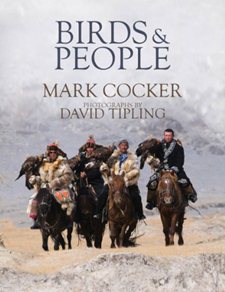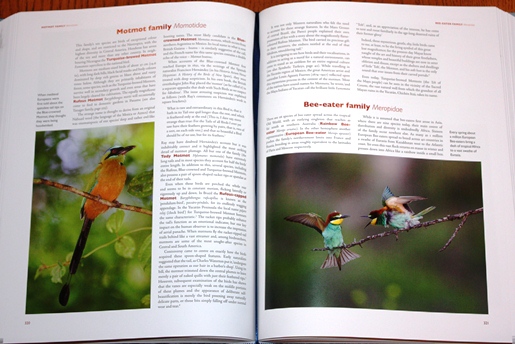Reviewed by Grant McCreary on December 17th, 2013.
Why are we so fascinated with birds? If you ask that question to birders, you’ll get a multitude of answers. But it’s not just birders. You will find references to birds throughout art, literature, and religion. And our lives can’t help but be touched by birds somehow, whether they are neighbors, pets, or food. With all of this influence and interaction, it’s no surprise that numerous writers have talked the subject. But none like Mark Cocker has done in Birds and People.
Birds and People is a sweeping exploration of why we cherish birds. Based on his own research as well as the observations of more than 650 contributors worldwide, you can tell that Cocker has provided an extensive exploration by simply looking at the book – it’s huge! Reading it only reinforces that impression, as you will discover many facets of the human-bird relationship that you’ve never even considered. But it’s not just thoroughness that sets this book apart, it’s also the organization. Like many other bird books, this one is organized by family.
Cocker looks at each bird family and tells how it has impacted our lives and culture. Parrots, for example, are most widely known for being desirable pets (unfortunately for parrot populations). But I was surprised to find out how prevalent they are in art, literature, and religious symbolism. Cocker also explains how they can be considered as pests and reports on their importance to Amerindians.
If you go by account length, the Pheasant, Fowl and Allies family – at 38 pages – has had the most impact on people. That’s unsurprising, considering that many of these birds are widely hunted and eaten. Indeed, the space devoted to Red Junglefowl (from which we get the domesticated chicken) alone is more than that of many entire families. But there are some families that haven’t impacted human culture much, if at all. Fifty-nine bird families don’t even warrant an account in this book (though they are listed in an appendix). Others receive scant coverage, such as the frogmouths (two paragraphs) and mousebirds (one and a half pages, with a large photo accounting for a third of that).
Then there are families that aren’t of general cultural importance due to their secretive nature. Think of such birds as pittas, antpittas, and scrubbirds. But that same furtiveness makes them highly attractive to one particular group of people – birders. So Cocker focuses on that. This leads to the most surprising aspect of the book (at least to me): it is one of the best explorations of the import of birds to birders that I’ve read.
So, this is a large, almost 600-page book that deals with, well, birds and people. Even to me that sounds a bit intimidating and, honestly, potentially boring. And it could have been, but for two important aspects. First, the organization is great; I much prefer the family accounts as opposed to breaking it down by subject. I’d think twice about reading a chapter on Birds as Crop Pests. But I dove right in on the mousebird account and found that they are widely persecuted due to the vast quantities of fruit they consume.
The other characteristic that prevents Birds and People from being boring is Cocker’s writing. In addition to being highly informative, the text can be insightful, profound, and humorous. The writing pulls you in and makes you want to read more. I have to be honest; I have not read every page of this book. But I’ve had a great time flipping through and reading accounts of both bird families that I’m very familiar with and those I’ve barely heard of, alike. In doing so, I’ve come across many gems such as this:
…the sheer living intensity of birds, such as tapaculos, stand in powerful contrast to the dark and inanimate disorder of their habitat. This encounter with unexpected beauty in the most forsaken places can give to the moment of observation a quality of startling epiphany.
Adding immeasurably to Birds and People are many photographs from renowned wildlife photographer David Tipling, who traveled the globe to collect images for this book. Most are of birds, of course, but many include people as well. Some of the latter are really interesting, especially those of people wearing headdresses and other beautiful items constructed from bird feathers. Others are much harder to look at, such as dead and caged birds being sold in market.
There’s still one important aspect of birds and people heretofore unmentioned – conservation. Cocker doesn’t spend a lot of time on this topic, as entire books can, and have, been written on it. However, it is at the core of this entire project. Birds and People isn’t just an interesting compilation of bird lore, it presents an extremely important message, which Cocker eloquently summarizes in the chapter on hornbills:
In many ways the drum [made in the image of a hornbill] symbolizes everything – all the cultural riches worldwide that derive from these birds – which we shall forfeit if we lose them. True, artefacts such as this will continue to be made and enjoyed for a time, perhaps for centuries, yet they will be like the light travelling from a star that has long since been extinguished. They will be without source and they will be lost finally in total darkness. And we will lose the hornbills and we will lose everything that hornbills have ever meant to us.
Recommendation
“This is an unusual bird book in that it is as much about human beings as it is about birds.” So begins Birds and People, and it is certainly true. Birders of all knowledge levels will learn much about birds from this book. But it’s the insight provided into our own species that is truly remarkable. It’s amazing to me just how much we get from birds, be it inspiration, pleasure, or food. Birds and People is an amazing resource, a pleasure to read, and one of the best bird books of the year.
Disclosure: I get a small commission for purchases made through links in this post.
Buy from NHBS
(based in the U.K.)
Disclosure: The item reviewed here was a complementary review copy provided by the publisher. But the opinion expressed here is my own, it has not been influenced in any way.








 (3 votes, average: 3.67 out of 5)
(3 votes, average: 3.67 out of 5)
Comment